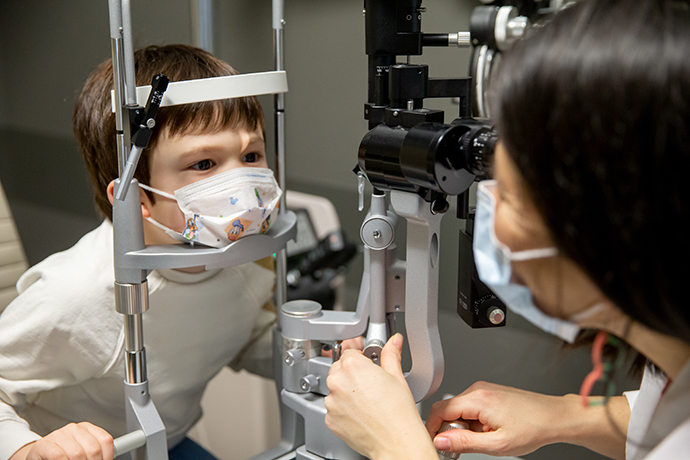
Myopia, also known as nearsightedness, is on the rise in the U.S. and around the world—particularly among children. The World Health Organization predicts that, if the current trend continues, half of the world’s population will be nearsighted by 2050 — with up to one-fifth at an increased risk of blindness due to complications of severe myopia. Casey clinicians and researchers are exploring several potential solutions to preventing and slowing this troubling trend.
Why is it happening?
There is a growing scientific consensus that at least one contributor to the epidemic is an increase in the amount of time we spend indoors on phones and computers (known as ‘near work’) versus time outdoors, in natural light.
How does that happen?
When children spend time looking up close, a significant part of the image is not focused properly on the edges of the retina, the light-sensing part of the eye. This blurred image causes the eye to grow longer, which leads to increased levels of myopia. Researchers are investigating what chemical or physical process is controlling this eye growth, as understanding why it is happening may allow us to control the process in the future.
Another factor that may be contributing to myopia is the growing amount of time children spend indoors. Studies have shown that children who spend more time outside are less likely to develop myopia than those who spend more time indoors. While we don’t yet understand exactly why, most pediatricians would agree that spending more time outdoors is good for everyone’s physical and mental well-being. Genes also play an important role in myopia. Children with one or both nearsighted parents are more likely to become myopic. But something else is happening — genes take many centuries to change, yet the prevalence of myopia in the U.S. increased from 25 percent in the early 1970s to nearly 42 percent just three decades later. It’s clear that something in the environment is driving the current uptick in myopia.
“We see it more in countries where there’s a more formal education system, where young children spend more time doing near work, either on printed material or a screen. Kids who spend more time outdoors seem to develop myopia at a lower rate. It’s not just a function of researchers keeping better records, or an increase in screening,” said Dr. Douglas Fredrick, Elks of Oregon Pediatric Ophthalmology Professor of Ophthalmology and director of the Elks Children’s Eye Clinic at OHSU Casey Eye Institute. “The trend is indisputable.”
What’s at stake?
Myopia affects a child’s academic success. Large studies have shown that children who have myopia, but don’t have corrective glasses, fall behind in school, because they can’t see the white board or Smart board at the front of a classroom, among other challenges. The problem goes beyond fitting more children with glasses. Children with higher degrees of myopia are more likely to develop sight-threatening complications later in life like cataracts, glaucoma, macular degeneration and retinal detachment. “Small or moderate degrees of myopia really don’t worry us. The problem is that, of the total number of people who develop myopia, five to 15 percent will become very nearsighted, in the high myopia category. That’s a problem when you’re looking at millions of people around the world at risk of vision loss,” said Fredrick. “If we can do something now to slow myopia development in children, we have the chance to prevent irreversible visual loss down the road,” said Fredrick.
Casey researchers pursue solutions
Casey is participating in a national, multi-center clinical trial that involves using a medication called atropine to delay and slow the progression of myopia in children. The medication takes the form of nightly eyedrops. It is widely used to slow myopia in adults, but it’s still not clear which dose is effective for slowing the rapid progression in children. The research is in early days, but the preliminary results are promising and further studies will help determine the ideal dose and timing. Right now, the only FDA-approved treatment for myopia progression is the use of specially-made soft contact lenses. Children as young as six can start wearing them, and research shows they slow myopia’s progression. One drawback is that the lenses are costly, and not yet covered by health insurance. Fredrick predicts that, once FDA approved for children, the atropine eyedrops may be even more effective than contact lenses. While drops are less expenses than contacts, they are not currently covered by health insurance, either.
Early screening is key
Thanks to a grant from the Oregon State Elks Association, the Elks Children’s Eye Clinic provides free vision screenings for preschoolers all over the state through its Preschool Vision Screening Program. The program collaborates with Head Start programs and public libraries to prevent vision loss in children by screening over 8,000 kids annually, referring over 700 kids every year to an eye doctor to be
checked for a potential vision problem, like myopia.
Educating parents and pediatricians
Now that the research connecting myopia to time indoors and near work has become so clear, Casey clinicians are talking to parents and pediatricians about the importance of spending time outdoors. “That could end up being the most important prevention measure we have,” said Fredrick.